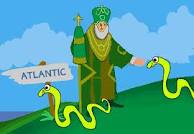Snakes, Fairies and St Patrick January 5, 2012
Author: Beach Combing | in : Medieval , trackbackA lead up to tomorrow’s epiphany gift to all readers: Scary Fairies: the Proto Edition.
Bede begins his Ecclesiastical History of the English in 731 with a geographical overview of the island of Britain and also, given its importance in the conversion of the English to Christianity, Ireland. It is a memorable passage not least because of what it has to say about snakes and other reptiles.
Ireland is broader than Britain and has a much healthier and milder climate; for the snow scarcely ever lies there above three days: no man makes hay in the summer for winter’s provision, or builds stables for his beasts of burden. No reptiles are found there, and no snake can live there; for, though snakes are often carried thither out of Britain, as soon as the ship comes near the shore, and the scent of the air reaches them, they die. On the contrary, almost all things in the island are efficacious against poison. In truth, we have known that when men have been bitten by serpents, the scrapings of leaves of books that were brought out of Ireland, being put into water, and given them to drink, have immediately absorbed the spreading poison, and assuaged the swelling. The island abounds in milk and honey, nor is there any lack of vines, fish, or fowl; and it is noted for the hunting of stags and roedeer. It is properly the country of the Scots, who, migrating from thence, as has been said, formed the third nation in Britain in addition to the Britons and the Picts.
Hibernia autem et latitudine sui status, et salubritate ac serenitate aerum multum Brittaniae praestat, ita ut raro ibi nix plus quam triduana remaneat; nemo propter hiemem aut faena secet aestate, aut stabula fabricet iumentis; nullum ibi reptile uideri soleat, nullus uiuere serpens ualeat; nam saepe illo de Brittania adlati serpentes, mox ut, proximante terris nauigio, odore aeris illius adtacti fuerint, intereunt; quin potius omnia pene, quae de eadem insula sunt, contra uenenum ualent. Denique uidimus, quibusdam a serpente percussis, rasa folia codicum, qui de Hibernia fuerant, et ipsam rasuram aquae inmissam ac potui datam, talibus protinus totam uim ueneni grassantis, totum inflati corporis absumsisse ac sedasse tumorem. Diues lactis ac mellis insula, nec uinearum expers, piscium uolucrumque, sed et ceruorum caprearumque uenatu insignis. Haec autem proprie patria Scottorum est; ab hac egressi, ut diximus, tertiam in Brittania Brettonibus et Pictis gentem addiderunt.
Now there is no question that Ireland, as many islands, has a slightly different set of fauna than its neighbours and this includes the absence of reptiles except the viviparous lizard that Bede forgot. (We can forgive him). New Zealand also has no snakes, Hawaii has only sea snakes… Attempts have been made to introduce reptiles (follow this link for a particularly silly one) in Ireland, but while the land did not exactly shrug these off, nor have the legless ones prospered.
A friend of this blog, Adrian Sterling from over at at the Anomalist brought up a question concerning the snakes. ‘I’m writing up a small piece about snakes in Ireland and I immediately thought of you when I read ‘Bede ( Hist. gent. Anglor i. 1) points out that there are no serpents in Ireland and if any are introduced from Britain they quickly die on breathing Irish air’. Why? Your post about the Proddies and Romans interactions with the Good Folk. The infuriatingly unsourced quote that the Gentry left England with the arrival of Protestantism. The tradition with the little people remains strong in Ireland (what do I know, I’m American) so perhaps they crossed over to the Emerald Isle and take up arms against these wee dragons. Are there any historical correspondences of animosity between snakes and the sidhe?’
The official answer is that the pagan Irish were quite happy with snakes but that St Patrick drove the devilish reptiles out. However, this legend clearly came after the fact to explain a natural absence and, in any case, is rather late first appearing in Gerald of Wales’ writings in the twelfth century. Nothing about St Patrick and snakes appears in the seventh-century saints lives, nor even in the Tripartite Life.
Knowing Irish lore a little what Beachcombing finds absolutely extraordinary – now Adrian has put him onto it – is that there is not a native Irish explanation, perhaps even one with pre-Christian traces, that explains why there were no reptiles in the land. In fact, writing this out there comes the suspicion that perhaps there was a legend but that the legend was too ‘pagan’ to be written down and that St Patrick as snake-banisher was a late and efficient Christian replacement of some unspeakable lore. If so then Adrian may be close to the truth. Were the sidhe credited with driving the slivering ones out?
Is Beach at fault: any early Irish legends about snake? drbeachcombing AT yahoo DOT com
***
28/March 2012: Karen writes in: In response to “Snakes, Fairies, and St. Patrick” wherein you were wondering about prechristian Irish mythology regarding snakes, this seems to be applicable. I say seems to be, because the author, A. V. Koltypin, did not give the reference on this page. However, since Fomorian lore is of Irish origin, if this quote is valid it must have come from Irish myth. Mr. Koltypin does mention that sources are in his book, apparently written in Russian.It mentions “holding an arm in a snake nest” a curious thing in a land without snakes. “Truly, to fight against Fomorians was all the same to punch a wall by head, to hold an arm in a snake nest, or to substitute a face to flame.” One more interesting note: here we might have the first source for the saying “It’s like beating your head against a wall” which we all still recognize to this very day… Thanks Karen!



